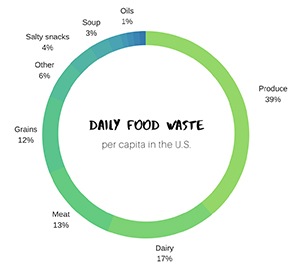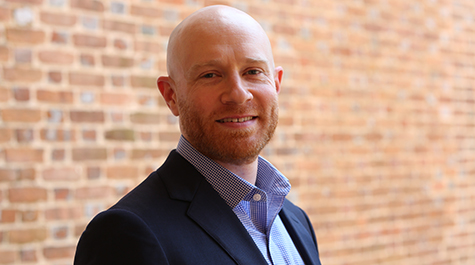Season’s eatings: An expert’s guide to reducing food waste
With holiday meals on the horizon, we sat down with Zach Conrad, assistant professor of nutrition in the Department of Kinesiology & Health Sciences at William & Mary, to discuss ways to reduce food waste. – Ed.
First, let me start by welcoming you to the William & Mary community. We’re excited to have you on the faculty. Let’s begin by talking about your research background and how it fits into the larger conversation about food waste.
It’s a real pleasure to be here. I’ve received such a warm welcome from students, staff and faculty. I'm a nutritional epidemiologist and a food systems scientist, so I have a real interdisciplinary perspective on food intake, health and sustainability. I look at these connections between how food is produced, what happens in the transportation, processing, and manufacturing of food and then, finally, what happens at the consumer level. I’m looking at the full system, which includes the impacts on human health and also the impacts on the environment.
In particular, as we make shifts in our diet, what happens to our health and the environment? The conventional wisdom has been that if we improve our diet, it’s going to be better for the environment. Some of the work that I'm doing is showing that that's true in some circumstances, but it’s not true in others. In fact, a healthy diet can be a real force for food waste.
That’s news to me. Unpack that for us.
What we found is that Americans waste about a pound per person per day of food and most of that is fruits and vegetables. In fact, people consuming the healthiest diets waste about 80 percent more food than people who consume the least healthy diets. Think about when you go to the grocery store. What is the first thing you see? It’s the produce section. That’s very intentional, because it creates this atmosphere of wholesomeness, but it also causes people to load up on fruits and vegetables that they may not actually eat after they take them home.
 There's also a lot of waste in the embedded agricultural inputs that go into growing that wasted produce. Farmers use fertilizers, pesticides, irrigation water, and cropland to produce those foods. If that food is wasted, those resources are wasted, too. That said, we want people to eat more fruits and vegetables, but at the same time we want them to waste less of them. People need to be eating the produce that they buy.
There's also a lot of waste in the embedded agricultural inputs that go into growing that wasted produce. Farmers use fertilizers, pesticides, irrigation water, and cropland to produce those foods. If that food is wasted, those resources are wasted, too. That said, we want people to eat more fruits and vegetables, but at the same time we want them to waste less of them. People need to be eating the produce that they buy.
What solutions can you recommend for the average consumer?
There are a number of strategies that I can recommend based on the scientific literature. It really starts with self-awareness. A lot of people are not even aware that they're wasting that much food. Recent research shows that three out of four people think that they're wasting less than the average person. Mathematically, that doesn't make sense, so being aware that you’re wasting food is a good place to start.
Next, I would recommend consumers align their food intake with dietary goals and really consider the amount of food that they are purchasing. Coupons and discounts are nice, but only when they don’t cause us to purchase more than we need. Plan your meals in advance and know what you already have. Review your food stocks before your go shopping, so you’ll know what you already have in your pantry, your fridge and your freezer.
Thanksgiving is right around the corner and in my family, and I imagine many others, it’s all about the food. What specific tips do you have for those of us planning our holiday meals?
Good question. If you’re having guests that means you’re going to be preparing a big meal and odds are that food is not going to be eaten all at once. This is where organizing your leftovers is key. Pack them in clear containers and store them where people can see them.
I'm just going to generalize here, but let’s say Mom prepared Thanksgiving dinner and Dad packed it up and put it in the fridge. Now, Son and Daughter are not going to have any idea where that food is if it’s not easy to see and it’s not well-organized. So, make sure your leftovers are as visible and accessible as possible. Also, remember that you can always freeze your leftovers. If you have more than the fridge can handle, save it in the freezer.
How should we take food waste into account when we’re planning our menu?
We already talked about this, but make sure you are considering portion sizes when you’re purchasing food. Make sure that what you’re buying aligns with what people will eat. Another tip I’ll recommend is to embrace canned and frozen vegetables. They’re really healthy alternatives to other packaged foods and it’s easy to store whatever you don’t use.
Alright, I’m gonna be honest with you. I’ve got a 10-month-old at home and just don’t have the bandwidth to do a lot of thoughtful meal-planning.
Trust me, you’re not alone. Most people have a lot on their plates — no pun intended — and reducing food waste can’t always be prioritized. But food waste is a serious issue. We’re throwing away 30 percent of our calories while, at the same time, about 13 million Americans are going hungry. One good thing about being a consumer today is that you have access to some cool technology that can help you along.
There are some really great meal-planning apps that are designed to cut down on food waste. Some apps have also been designed to help with food shopping, cooking with food scraps and food storage. For example, LoveFoodHateWaste will provide recommendations for recipes based on your food scraps and FoodKeeper will provide you with tips for food storage.
Now you have a handful of strategies to reduce your food waste, so you can enjoy family time.















